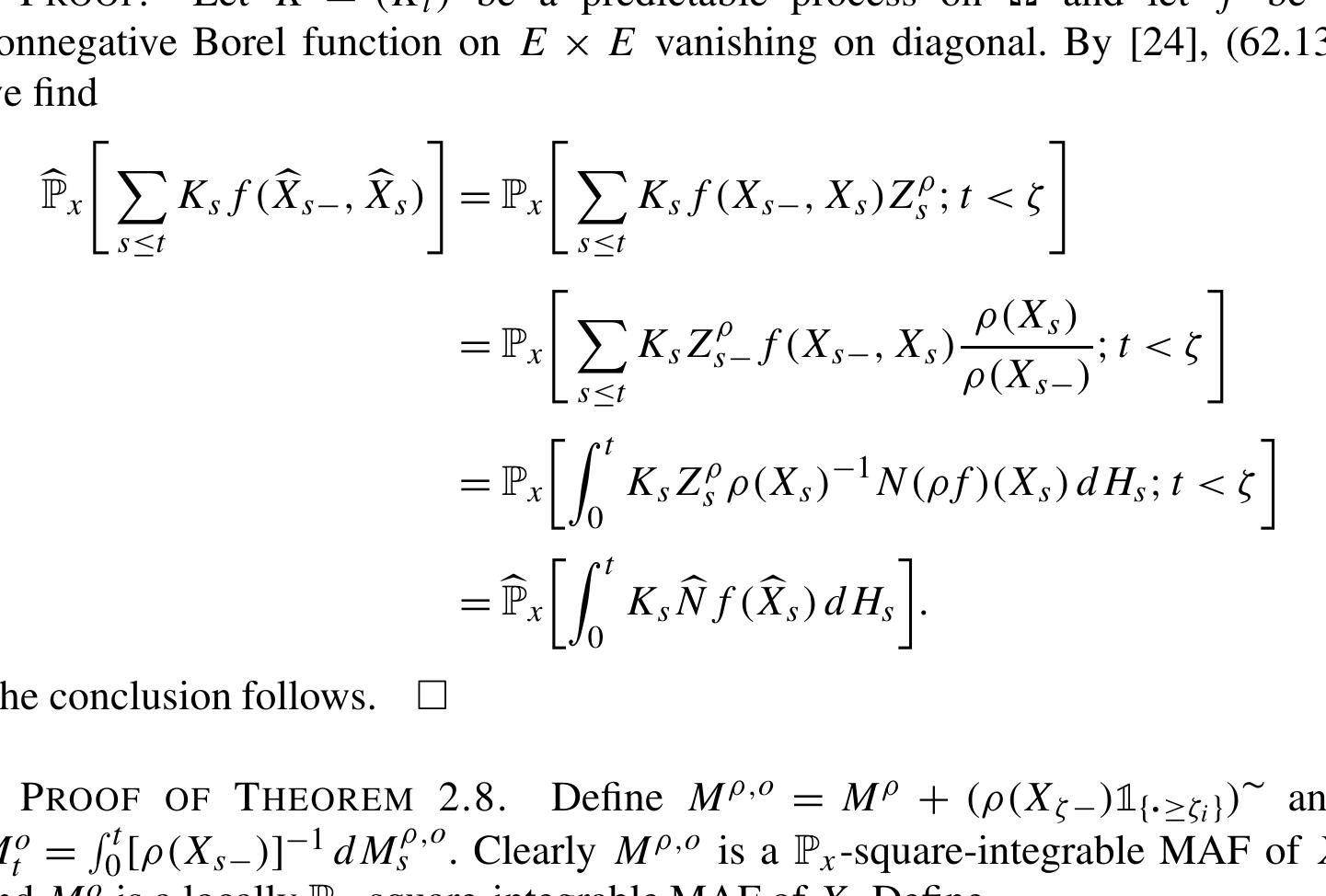Absolute continuity of symmetric Markov processes (original) (raw)
Abstract
We study Girsanov's theorem in the context of symmetric Markov processes, extending earlier work of Fukushima-Takeda and Fitzsimmons on Girsanov transformations of "gradient type." We investigate the most general Girsanov transformation leading to another symmetric Markov process. This investigation requires an extension of the forward-backward martingale method of Lyons-Zheng, to cover the case of processes with jumps.
Figures (1)

Loading Preview
Sorry, preview is currently unavailable. You can download the paper by clicking the button above.
References (27)
- ALBEVERIO, S. and SONG, S. (1993). Closability and resolvent of Dirichlet forms perturbed by jumps. Potential Anal. 2 115-130.
- CHEN, Z.-Q., MA, Z.-M. and RÖCKNER, M. (1994). Quasi-homeomorphisms of Dirichlet forms. Nagoya Math. J. 136 1-15.
- CHEN, Z.-Q. and ZHANG, T.-S. (2002). Girsanov and Feynman-Kac type transformations for symmetric Markov processes. Ann. Inst. H. Poincaré Probab. Statist. 38 475-505.
- FITZSIMMONS, P. J. (1995). Even and odd continuous additive functionals. In Dirichlet Forms and Stochastic Processes (Z. M. Ma, M. Röckner and J. A. Yan, eds.) 139-154. de Gruyter, Berlin.
- FITZSIMMONS, P. J. (1997). Absolute continuity of symmetric diffusions. Ann. Probab. 25 230-258.
- FITZSIMMONS, P. J. (2001). On the quasi-regularity of semi-Dirichlet forms. Potential Anal. 15 151-185.
- FUKUSHIMA, M. (1982). On absolute continuity of multi-dimensional symmetrizable diffu- sions. Functional Analysis in Markov Processes. Lecture Notes in Math. 923 146-176. Springer, Berlin.
- FUKUSHIMA, M., OSHIMA, Y. and TAKEDA, M. (1994). Dirichlet Forms and Symmetric Markov Processes. de Gruyter, Berlin.
- FUKUSHIMA, M. and TAKEDA, M. (1984). A transformation of symmetric Markov processes and the Donsker-Varadhan theory. Osaka J. Math. 21 311-326.
- GETOOR, R. K. and SHARPE, M. J. (1981). Two results on dual excursions. In Seminar on Stochastic Processes (E. Çinlar, K. L. Chung and R. K. Getoor, eds.) 31-52. Birkhäuser, Boston.
- GETOOR, R. K. and SHARPE, M. J. (1984). Naturality, standardness and weak duality for Markov processes. Z. Wahrsch. Verw. Gebiete 67 1-62.
- GONG, F., RÖCKNER, M. and WU, L. (2001). Poincaré inequality for weighted first order Sobolev spaces on loop spaces. J. Funct. Anal. 185 527-563.
- HE, S. W., WANG, J. G. and YAN, J. A. (1992). Semimartingale Theory and Stochastic Calculus. Science Press, Beijing.
- JACOD, J. (1978). Projection prévisible et décomposition multiplicative d'une semi-martingale positive. Séminaire de Probabilités XII. Lecture Notes in Math. 649 22-34. Springer, Berlin.
- KUNITA, H. (1969). Absolute continuity of Markov processes and generators. Nagoya Math. J. 36 1-26.
- KUNITA, H. (1976). Absolute continuity of Markov processes. Séminaire de Probabilités X. Lecture Notes in Math. 511 44-77. Springer, Berlin.
- KUNITA, H. and WATANABE, S. (1967). On square integrable martingales. Nagoya Math. J. 30 209-245.
- KUWAE, K. (1998). Functional calculus for Dirichlet forms. Osaka J. Math. 35 683-715.
- MA, Z.-M. and RÖCKNER, M. (1992). Introduction to the Theory of (Non-Symmetric) Dirichlet Forms. Springer, Berlin.
- OREY, S. (1974). Conditions for the absolute continuity of two diffusions. Trans. Amer. Math. Soc. 193 413-426.
- OSHIMA, Y. (1987). On absolute continuity of two symmetric diffusion processes. Stochastic Processes-Mathematics and Physics II. Lecture Notes in Math. 1250 184-194. Springer, Berlin.
- OSHIMA, Y. and TAKEDA, M. (1987). On a transformation of symmetric Markov processes and recurrence property. Stochastic Processes-Mathematics and Physics II. Lecture Notes in Math. 1250 171-183. Springer, Berlin.
- SHARPE, M. J. (1971). Exact multiplicative functionals in duality. Indiana Univ. Math. J. 21 27-60.
- SHARPE, M. J. (1988). General Theory of Markov Processes. Academic Press, San Diego.
- TAKEDA, M. (1999). Topics on Dirichlet forms and symmetric Markov processes. Sugaku Expositions 12 201-222.
- WALSH, J. B. (1972). Markov processes and their functionals in duality. Z. Wahrsch. Verw. Gebiete 24 229-246.
- YING, J. (1996). Bivariate Revuz measures and the Feynman-Kac formula. Ann. Inst. H. Poincaré Probab. Statist. 32 251-287.
